Toxic Landscape Plants

What to plant with caution
While landscape plants provide many benefits, including an opportunity for people to engage with the natural world, some contain chemicals or compounds that are poisonous to humans, pets or livestock. These plants can still be used in the landscape, but special consideration should be given to areas where small children or pets might come into contact with them.
Although they seem to come from the dark side of botany, toxic plants aren’t evil—they produce harmful compounds for a reason, such as to deter insects from feeding on them or to protect against microbial infections. Some can even produce toxins that inhibit the growth or reproduction of nearby plants, allowing them to outcompete for resources.
Understanding which plants are poisonous can help you prevent accidental exposure and make informed decisions when designing your garden. Below are some poisonous plants that are used often in landscapes throughout Florida and are harmful if ingested.
Oleander (Nerium oleander)

Oleander is a shrub or small tree with dark green leaves and flowers in shades of white, pink, red, coral and yellow. It reaches a height between 6.5 and 19.5 feet tall and often blooms in spring and fall. All parts of the plant are poisonous to humans and animals; ingestion can cause diarrhea, abdominal pain, headache, vomiting, nausea, and cardiovascular symptoms. Sap released from freshly cut leaves and stems can cause contact dermatitis. If the plant is burned, it can release toxins into the air and cause respiratory distress.
Sago Palm (Cycas revoluta)

The sago palm is not a true palm, but gets its common name for its resemblance to palm trees. It is an evergreen cycad with dark green palm-like leaves with pointed tips. The reproductive structures lie in the center of the plant, with the female organ consisting of a globed flowerhead and the male organ as a large yellow cone. All parts of the sago palm are highly toxic to humans and animals, with symptoms developing within 12 hours of ingestion. These include vomiting, abdominal pain, diarrhea, headache, dizziness, and weakness. In some cases, sago palm has been fatal to dogs when consumed.
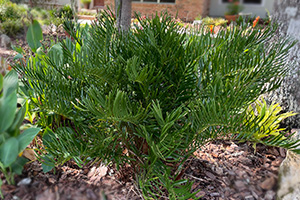
Coontie (Zamia floridana)
Coontie’s leaves resemble the shape of a feather and unfurl like a fern. It grows low to the ground with a woody structure and produces bright orange seeds. All parts of the plant are poisonous, but the seeds are the most toxic. Symptoms of poisoning include dark stools, vomiting, headache, stomach pain, diarrhea with blood, liver failure, and in some cases, death.
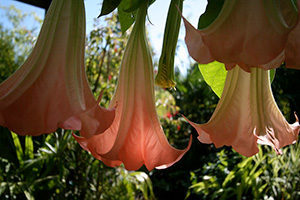
Angel’s Trumpet (Brugmansia spp.)
Angel’s trumpet can reach heights of 30 feet tall when grown in tropical and subtropical climates. The leaves range in shape depending on the species and the flowers are trumpet shaped in shades of pink, orange, white, yellow, gold, peach, and pink. All parts of the plant are poisonous, and symptoms include dilated pupils, blurred vision, confusion, hallucinations, increased blood pressure and heart rate, dryness of skin, and suppressed salivation.
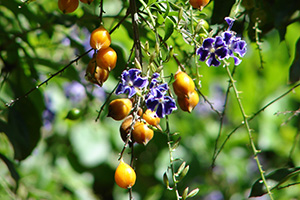
Golden Dewdrop (Duranta erecta)
Golden dewdrop gets its name from the clusters of orange-to-yellow fruits that droop from its branches. It grows as an evergreen shrub or small tree, reaching up to 18 feet in height. Its small, clustered flowers are often purple, white, violet or blue. The leaves and fruits are highly toxic, and symptoms of poisoning include drowsiness, fever, nausea, vomiting and seizures. There have been some cases where the berries and leaves were fatal for dogs and cats.
Common Lantana (Lantana camara)
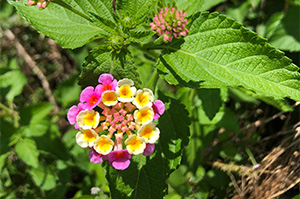
Common lantana is considered invasive by the UF/IFAS Assessment of Non-Native Plants. It can be sub-erect, climbing or scrambling, reaching up to 17 feet tall. Tubular blooms appear year-round, ranging in color from red, yellow, white, pink or orange. All parts of the plant are poisonous. Signs and symptoms of lantana poisoning depend on the amount of the plant consumed. Symptoms consist of excessive skin sensitivity to sunlight, liver damage, jaundice, swelling of ears and eyelids, and reddening of and discharge from eyes.
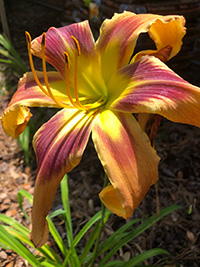
Daylily (Hemerocallis spp.)
Daylilies have showy, trumpet-shaped flowers that come in hues of yellow, orange, red, pink, purple, white, and combinations of these. The leaves rise directly from the ground from a fleshy rhizome. All parts of the plant are toxic to dogs and cats—even a small amount can have serious consequences. It is known to cause acute kidney injury in cats. Symptoms include gastrointestinal irritation, followed by dehydration, vomiting, and then renal failure. Seizures are also possible.
This is not an exhaustive list of poisonous plants in Florida. For a more comprehensive list of Florida’s toxic plants, visit the Florida-Friendly Landscaping™ toxic plants web app. The most important thing to remember is to never eat a plant if you are not 100% sure what it is (or if it is toxic) and be cognizant of what and where you plant.
NOTE: If you suspect poisoning from a plant, call your local veterinary hospital in the case of pets, and for humans, the poison control center at 1-800-222-1222. Call 911 right away if the individual collapses, has a seizure, has trouble breathing, or can’t be awakened.
Also on Gardening Solutions
- Angel’s Trumpet
- Coontie
- Daylilies
- Deadly Plants
- Golden Dewdrop
- Lantana
- Oleander
- Petscaping
- Sago Alternatives
More from UF/IFAS
- Common Poisonous Landscape Plant Species in Florida–Ask IFAS
- Poisonous Plants in Your Florida Garden: Six Species to Know–Florida Museum
- Toxic Landscape Plants–Florida-Friendly Landscaping™ Program
